New perk: Easily find new routes and hidden gems, upcoming running events, and more near you. Your weekly Local Running Newsletter has everything you need to lace up! Subscribe today.
I learned about Hyrox through an Instagram ad—isn’t that how all great stories begin? It was a video of a handful of sweat-doused athletes, both men and women, lunging with massive sandbags slung over their shoulders, slogging through sled pushes with gritted teeth, and pumping their arms while running around an arena.
I was intrigued. No, I was obsessed.
I looked at the skills required to compete–endurance, strength, agility, to name a few— and was immediately intimidated and uncomfortable. It seemed out of reach for me, which made it all the more enticing. As I do with many obsessions, I went down a Google rabbit hole to find answers and learn everything I could about the fitness race.
Hyrox is a timed fitness competition that takes place entirely in a gym and is made up of eight functional strength training movements with 1 kilometer of running between each, for a total of 8K (basically 5 miles) or running total. The clock keeps running throughout the entire competition until you finish the wall balls section and run through the finish line arch. Though there is no time limit, it can take anywhere from 60 minutes to an hour and 32 minutes to complete a race. Hyrox is aimed toward the “hybrid athlete,” a trendy word for someone who balances strength and endurance training.
Started in Germany in 2017, Hyrox was popularized by CrossFit enthusiasts in Europe, and now has sold out races across the U.S. But unlike CrossFit, which involves highly technical movements, Hydrox was designed with functional, more accessible movements in mind.
Here’s what a Hyrox looks like:
- 1K run
- 1,000-meter ski erg (an exercise machine that mimics Nordic skiing)
- 1K run
- 50-meter sled push
- 1K run
- 50-meter sled pull
- 1K run
- 80 meters of burpee broad jumps
- 1K run
- 1,000-meter row
- 1K run
- 200-meter farmer’s carry
- 1K run
- 100-meter sandbag lunges
- 1K run
- 100 wall balls
The thing is, I’m a runner by trade. I’m in the gym when I need to be for strength training (which is uber important for running efficacy and injury prevention), but most of my effort remains out there in my speed workouts, tempo runs, and long Sunday sessions.
So I signed up. After all, that’s why I registered for my first marathon: the desire to do something hard, something I instinctively reacted to with, “I can’t do this.”
You can compete in a Hyrox a few different ways. There is the professional division (both men and women), which anyone can sign up for. But you will be left in the dust if you aren’t prepared for the higher weight mandated in each event (445 pounds for sled push, 337 for sled pulls, two you 70-pound kettlebells for farmer’s carry, 66 for sandbag lunges, and 20 for wall balls) and the top-tier athleticism you see among competitors. Athletes in the pro division are often trying to qualify for the Hyrox World Championships, which happens once a year in a different part of the world. (The 2024 championships were held in Nice, France.)
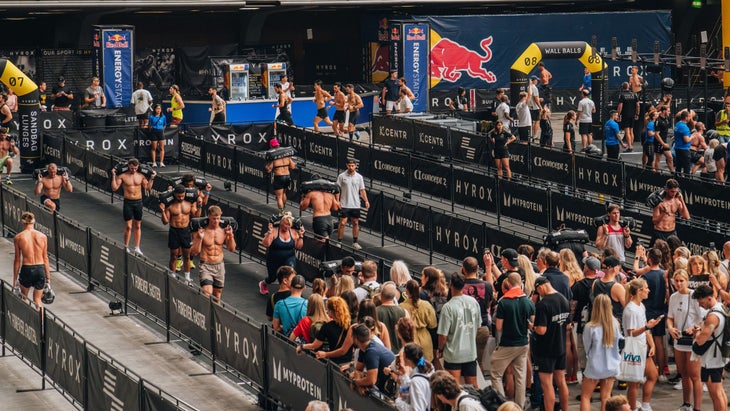
A pro qualifies by achieving one of the top places in their respective age group and division across any Hyrox race in the season, though the number of qualifying spots available at each competition is dependent on the total number of participants. At this year’s Hyrox World Championships, 175,000 elites competed for a total purse prize of $150,000, which was split amongst the men and women top 11 finishers. The first place winners, Austrian Alexander Roncevic and American Megan Jacoby, received $25,000.
Outside of the pro field, there’s both a men and women singles division, men’s doubles and women’s doubles (where you complete a Hyrox with a partner of your same sex), and mixed doubles. If you compete in the doubles division, you and your partner’s ages will be averaged to find your relevant age group. You can also sign up for a Hyrox relay, which you do as a team of four, each person designated to two different exercises.
I chose to compete in the mixed doubles division with a partner, my 32-year-old friend, Davis, who is as fit as they come and familiar with functional movements and heavy weight, but, prior to training, wasn’t as comfortable with running. We were both intimidated, and thought it would be a great experience to share together at the Hyrox in Dallas on November 23.
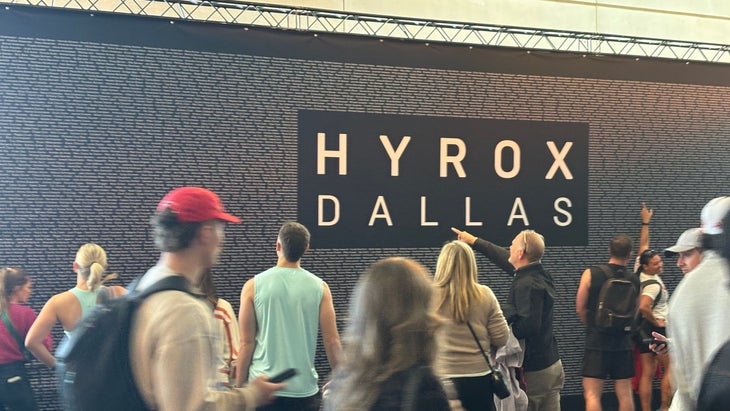
Hyrox Training Vs. Marathon Training
Though it’s not required, I highly recommend finding a Hyrox-experienced coach for your first competition. I started training with CrossFit coach and Hyrox expert Sarabeth Clark in late August, which gave me about four months to get prepared. Clark had me do three Hyrox-focused, functional movement-filled workouts a week, which consisted of “AMRAPS” (as many reps as possible), running anywhere between 200-meter to 1000-meter repeats on tired legs, rounds for time, and “accessory work”—basic strength lifts like bicep curls, rows, squats, and deadlifts. Warmups were mandatory, and usually involved movements like easy rowing, air squats, band work, or a few pushups. My running coach, aware of my goal of Hyrox, had me continue a maintenance running schedule, with two 5-6 mile moderate runs, a speed workout, and a long run on Sundays. I really wanted to focus all my efforts into Hyrox, so I decided I wouldn’t mix training for any particular race, and instead just wanted to keep up a healthy endurance schedule.
The Hyrox workouts were tough. In the beginning, my heart rate was out of control. But about a month into training, I started becoming accustomed to the high intensity, high weight work. On paper, the workouts were intimidating—100 burpees? Excuse me?! But I quickly learned my ideal pacing, and realized that my body could do a lot more than I thought.
With marathon training, the pain and exhaustion I might feel during workouts or long runs is at least, in my mind, consistent. I can fight through it with some grit and mental determination. I was not accustomed to the acute bursts of “pain” and, sometimes, complete muscle failure. There were instances I had to put down the kettlebells or dumbbells mid set because I physically couldn’t lift them anymore. And that was to be expected. Whereas if I had to stop in the middle of my run because my legs were so tired, that might indicate that my pace was too fast or that I hadn’t recovered properly from my last workout. I personally would never run to failure in my marathon training.
And in my marathon training, I at least knew where I stood prior to race day. I knew I would be able to run at least 20-22 miles, because I did so in my workouts. But Hyrox was a little more unpredictable. In week eight of training, Clark had me do half a Hyrox, which was all the movements just cut in half, so I could gauge how I felt and what I needed to work on. However, it wasn’t even close to the full, compared to how my last long run in marathon training is at least comparable to 26 miles.
The one similarity between Hyrox and marathon training was my adherence to recovery. After every workout, I took the time to cool down, use a foam roller, and stretch. This, paired with the fact that the movements I was doing were super functional, kept me from getting injured. Sore, yes. Injured, no.
Hyrox Day (Dun, Dun, Dun!)
The event took place at the Kay Bailey Hutchinson Convention Center, which was set up with all the stations and a corral-ring for competitors to run their mandated 1K. Each station was identified by a huge blow-up arch, and there were “Rox Zones,” areas where athletes can quickly grab water or Gatorade, between each station. You could bring whatever fuel or water you wanted on the course, but you couldn’t have a spectator hand you anything during the competition.
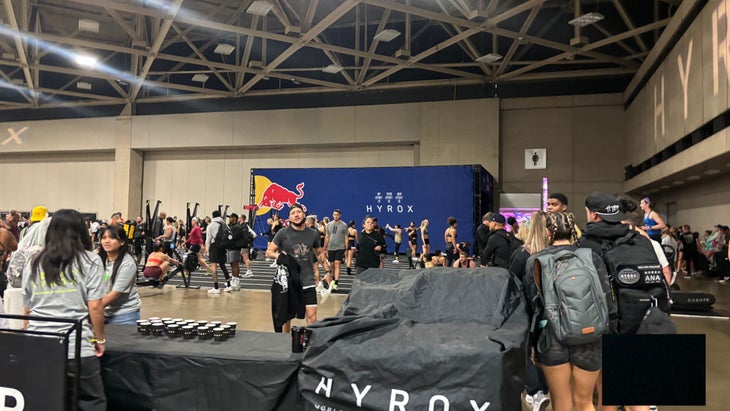
There was a huge turf-laden warmup area sequestered off to the side where only athletes could go stretch, run on one of 10 treadmills, hop on a stationary bike, or practice an exercise. There were several sleds, ski erg machines, kettlebells, and sandbags available. Davis and I took advantage of that and practiced our transitions, as there are several rules when you’re competing as a pair. You each will do the same number of exercises as the singles would, but divided between yourselves however you see fit. One person will start the exercise while the other person follows or waits, then hops in once you choose to swap. Doubles have to adhere to the same form rules that the singles do, in addition to “legal” transitioning. For example, the sandbag can never touch the ground, you can’t pass the ski erg handles over to your partner, and you have to set the kettlebells down during the farmer’s carries before the other person can pick them up.
Hyrox has plenty of technical briefings they strongly recommend athletes watch before competing, which are super helpful. Clark also gave me tons of insight, but no matter how prepared I thought I was, there were a few things I could only learn during the event itself.
Here are some takeaways from my first-ever Hyrox.
1. I went out too hard on the ski erg machine.
We ran the first 1K (two laps around the arena) and then sped to the first station—1,000-meter ski erg. For the unacquainted, the ski erg was initially designed as a cross-country skiing tool because it mimics the power needed for the sport. Davis and I split 1,000 meters into 250 meters each, so we each did about 500 meters. But I sped through my share too quickly and burned myself out. By the time I was ready for the second station, sled pushes, I was feeling exhausted already.
I would recommend attacking the ski erg slow and steady, powerful but moderately paced. Spiking your heart rate this early on isn’t worth it, and it’ll take you a few stations to recover.
2. I was not ready for the weight of the sled pulls and pushes.
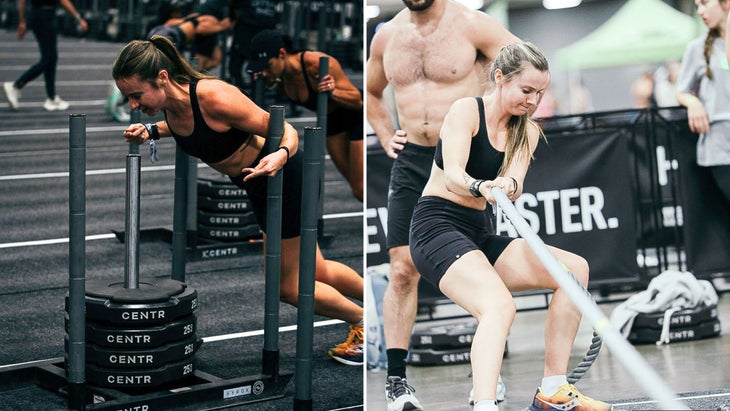
Even though I knew the weight I would have to pull and push prior to the competition (335 pounds for the push station and 227 pounds for the pulling station), I didn’t practice long enough or hard enough in my training. The minute I started pushing the sled, alarm bells went off in my head. That. B*tch. Wasn’t. Moving. There was also a technique to pushing I hadn’t tried but saw other people doing, so I took a risk and implemented it then and there—pressing the crooks of my elbows into the sled bars. It helped tremendously and took some of the pressure off my legs.
The sled I was using in my training, the one available to me at my gym, was not up to par. It moved too easily on what happened to be sloped turf and the pulling rope came off at least four times a training session. But I thought, “Eh I’ll wing it anyways.” Listen, folks. Don’t. Wing. Anything. In. Hyrox.
3. The spectators came out in full force.

I didn’t know what to expect when it came to Hyrox spectators, but the arena was packed. The design of the course allowed for people to follow their athlete along the course, so there were tons of people at every station and all around the running lap. People held signs, blew whistles, and cheered just as enthusiastically as fans at the World Marathon Majors.
4. My running background came in handy—big time.
Clark told me that my running experience was going to be a big benefit during Hyrox, but I didn’t fully understand what she meant until the day of. In a doubles team, you and your partner have to remain an arm’s length distance away while you’re running, and because the track is packed with people, we found it was easier to stagger ourselves one in front of the other. I led out in front because I was comfortable pacing, and Davis stayed right on me. Though I was gassed after most of the exercise stations, I found my time to recover was during the running. I got stronger and stronger with each lap, thanks to Clark having me run on tired legs for much of my training.
One tip I have is to talk out your race pace prior to the event, and keep talking through your laps. Every now and then, I’d call out to check how he was feeling, and we would adjust the pace faster or slower if needed.
5. The farmer’s carry station was easier than I thought (thanks to training).
Station seven was 200 meters of farmer’s carries with two 52-pound kettlebells. I was really worried about this one in my training, so Clark implemented more of them in my workouts to help with grip strength. Surprisingly, this was less difficult than I thought it would be. It was still incredibly challenging, but I found myself able to go more lengths than I thought I would.
6. No matter how many wall balls you do in training, they’re always going to suck.
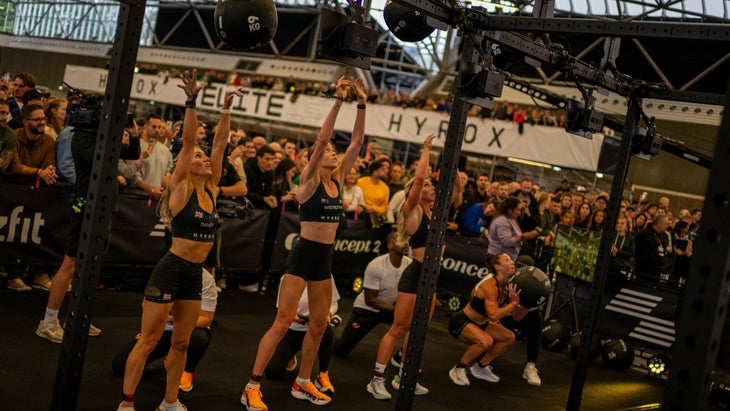
I did a lot of wall balls during Hyrox training—a lot. I thought, out of all the exercises, this would be easiest. It’s the very last station, so I was totally cooked by that point. My legs felt stronger than my arms, which were noodles. Between us, Davis and I had to do 100 wall balls, and he had to do a good portion of them because I was slowing us down. But what helped was doing them in increments—10 at a time for me, 20 at a time for him. And always let the ball fall to the ground when you’re swapping places, never catch it and hand it over.
7. Communicating with your partner (if you have one) is essential.
Not only was doing this with Davis really fun, but it was necessary to get the job done. I didn’t anticipate the amount of communication—whether it was verbal or hand signals—that we’d need on the course. We were constantly checking in on each other (shouting to be heard among the spectators and other athletes) to see when one of us could go longer or needed to switch to rest for a few seconds.
Would I Do It Again?

During the competition, I kept thinking, “This is so hard, I’ll never do this again.” But the minute we finished our 100 wall balls and ran under the finish line arch, I was so full of gratitude. Though marathons and Hyrox are vastly different, I get the same rush from both. There’s something about accomplishing something painful, difficult, and potentially soul-crushing that makes you want to do it all over again.
Long distance runners do things like marathons and ultras in part because it’s hard. The challenge is addictive, which is why so many of us continue to come back for more. The training for Hyrox was different from my typical marathon training, but I found that the adherence to a schedule, attention to recovery, and post-race endorphins were the same. Personally, I wouldn’t be able to train for and complete a Hyrox while in the middle of a marathon training block. My legs were usually pretty compromised after my workouts that I couldn’t run as well as I normally do—though that did lessen over time once I got used to it.
But for me, that was OK, because I had a goal in mind. I loved that I didn’t have to stop my running schedule altogether, and wasn’t too upset about not keeping up my regular endurance efforts because I enjoyed the process of Hyrox so much. I knew that I could not only return to my marathon training after, but would actually be stronger for it.
So, would I do it again? Ask me again in a few days—after my body stops hurting. But all signs point to yes.
